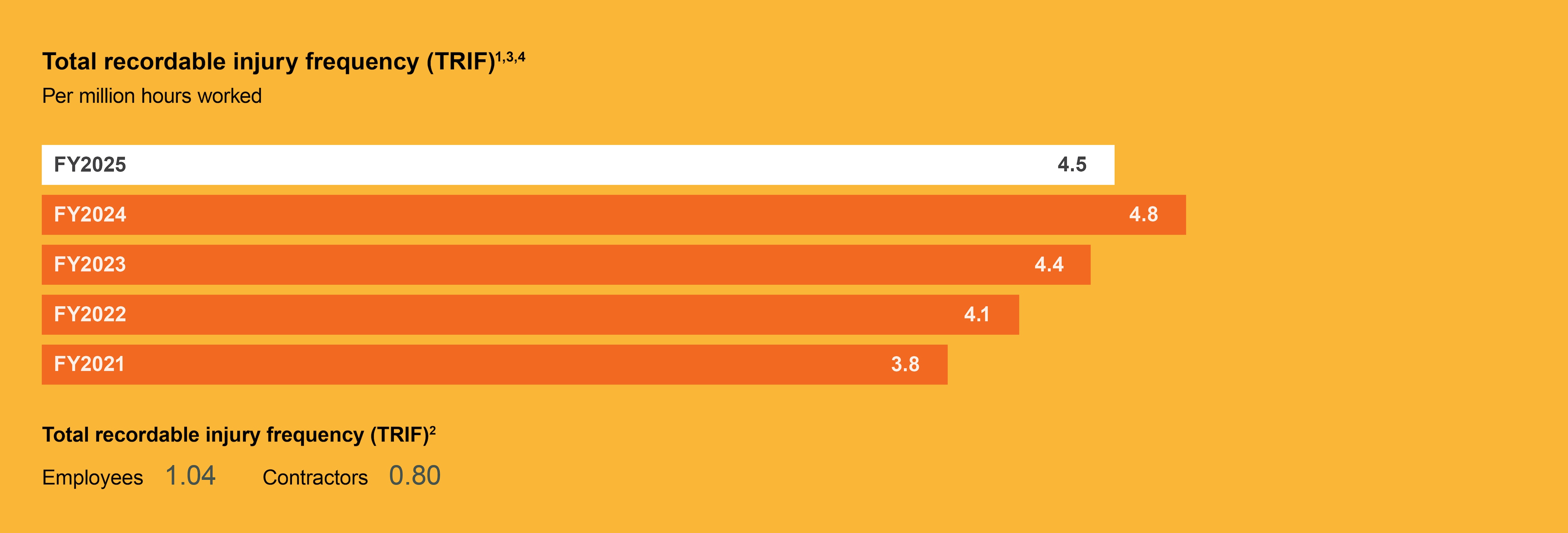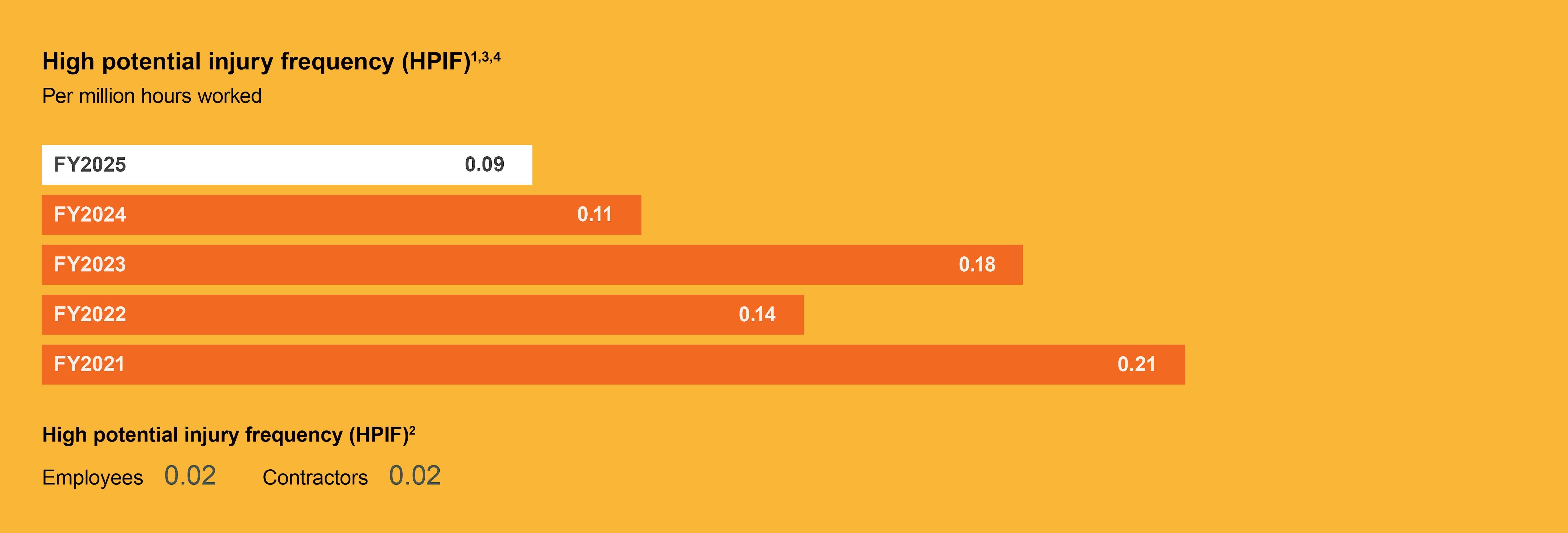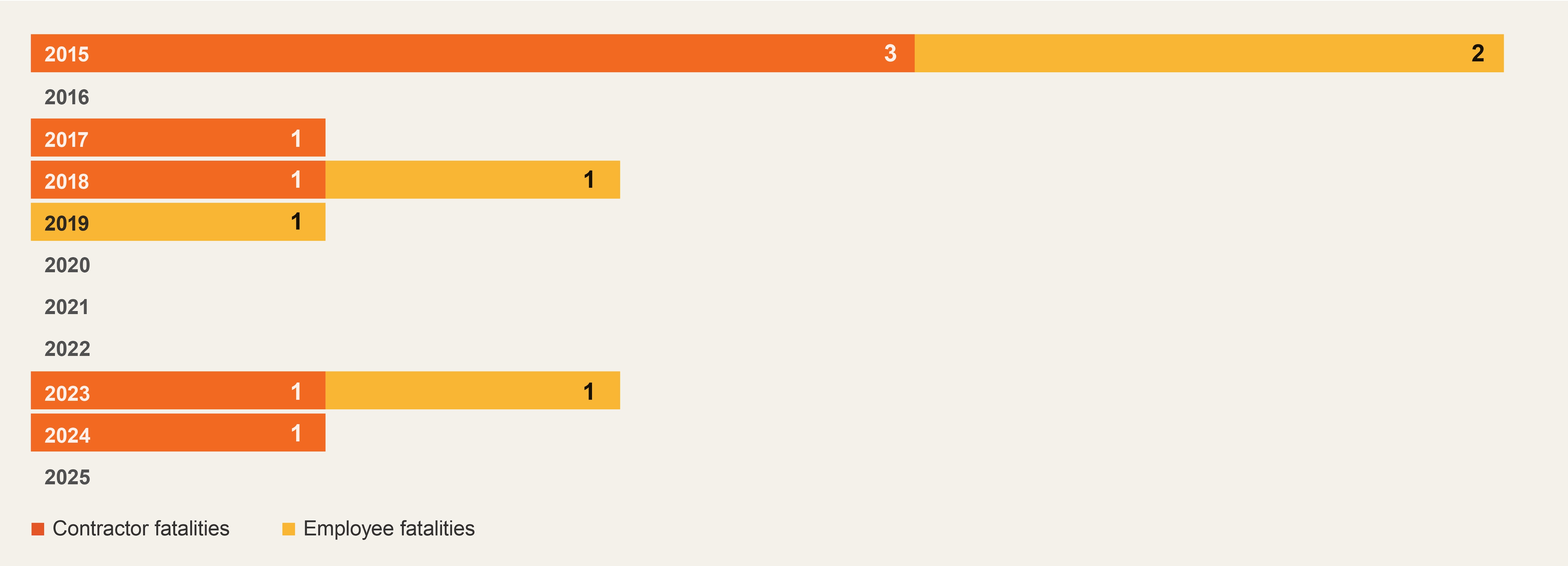Nothing is more important than protecting the safety and wellbeing of our workforce.
Our ambition
We maintain our commitment to eliminate fatalities and serious injuries. Our key focus areas include:
- leading authentically and embracing a culture of care and trust, to make it feel safe for everyone to speak up so we can learn and improve together
- building on the strength and success of our BHP Operating System and our Field Leadership Program to further integrate safety into the way we work, grow capability through coaching, collaborate, plan and execute safe operations
- being humble and curious about learning proactively from everyday successful work enabled through our global Field Leadership Program, to optimise our learning potential and ability to share insights and opportunities
- management of our highest material safety risks through effective control verification
- leveraging technology in new ways to help keep our people safe and explore its ongoing application to support future safety risk management improvements
- improving safety learning by broadly sharing high potential events, and enhancing the quality of problem solving and investigations
- working collaboratively with our contractors and vendors to support safe work execution
We finalised our investigation into the fatal incident at Olympic Dam in April 2023 and the findings were shared internally to help us improve the way we execute work safely. What we learned from this investigation plays a crucial role in our ongoing efforts to strengthen our safety systems and risk control framework to prevent fatalities involving vehicles and mobile equipment.
Our approach and position
At BHP, achieving safe outcomes is at the heart of how we operate and is deeply aligned with Our Charter values, which are central to the way we conduct our business: do what’s right, seek better ways, and make a difference. The safety of our people and the communities where we operate must always come first. By their nature, our working environments potentially expose our workforce to risks. Our objective is to identify and assess those risks, and implement and verify controls to prevent or mitigate their potential impacts. Our assessment of safety risks also includes, where relevant, consideration of potential community impacts and associated risk controls.
We continue to engage with our workers to learn and improve as we believe they are instrumental in helping us to achieve performance improvements and safe operational outcomes. We communicate and collaborate with our workforce via several global and local communication pathways across the organisation, including:
- internal Global Standards updates (e.g. the Safety Global Standard)
- integration of safety leadership behaviours and effective safety risk management practices within our operational work routines
- through our global Field Leadership Program via authentic and trusting two-way conversations between leaders and their teams, making it feel safer for the workforce to speak up and share valued insights relating to work issues, safety risks and controls, and ways to improve work
- focused learning opportunities, via problem solving and investigations
- meetings throughout the life cycle of work, before work starts (e.g. Pre-starts/Safe Starts, toolbox talks), during tasks when risks may change and at completion to support effective shift handovers
- sharing learnings via other digital media (e.g. leadership messages, Bright Spots, asset or operation high potential event shares, BHP intranet articles and impactful storytelling)
-
Governance and oversight
For information on the role of the BHP Board in overseeing our approach to sustainability and delivery on our sustainability ambitions, refer to the Sustainability approach webpage.
Our operated assets and functions must meet the Global Standards (where applicable) and assess and implement further controls in accordance with their local risk profiles, standards and regulatory requirements.
The Safety Global Standard requires the implementation of controls to manage identified risks using the hierarchy of control (elimination, substitution, isolation/separation, engineering, administrative, personal protective equipment) in:- design and construction of new operated assets, facilities and equipment
- changes to existing operated assets, facilities and equipment
- design, planning, scheduling and execution of work
-
Engagement
Collaboration with our workforce is vital, so we ensure subject-matter experts across our operated assets and functions are engaged in the development, implementation, and evaluation of the Global Standards relevant to safety. Formal joint leadership and worker health and safety committees exist within a number of our operated assets and functions. Those committees meet on a regular basis and general responsibilities include identifying and implementing ongoing health and safety learning and improvement opportunities.
Fatality Elimination Program
It is paramount that we continue to learn, improve and focus on opportunities to verify and strengthen our safety risk control framework to more effectively manage and prevent risk of fatalities.
The Fatality Elimination Program (FEL), which began in 2020 and is a five-year program, provides a solid foundation for delivering strong safety performance through the standardisation and implementation of fatal risk controls (FEL controls). In FY2025, we completed incorporation of most of the recommended FEL controls as requirements under our Global Standards (Safety, Process Safety Management and Geotechnical). This important work also included the introduction of a new global specification for vehicles, which emphasises standardisation of controls, and the use of new technology designed to prevent fatalities related to vehicles and mobile equipment.
At the end of FY2025, having embedded the defined set of Global Standards, the FEL program shifted to an asset-led model for fatal risk control management. This transition formally closes out the five-year, globally led FEL program. This important change provides our operated assets with ownership of their respective control plans and enables them to tailor and apply FEL controls relevant to their specific risk exposure scenarios. This is supported by Global Standards (including the new global specification for vehicles) and audit and assurance processes.
We will continue to enhance our approach to safety risk management and effective control verification, and advance our understanding of what conditions and factors influence incident causation and consequence severity.
The elimination of fatalities is a critical milestone in our FY2026 social value scorecard, together with focusing on improving our high potential injury frequency rate for employees and contractors. This is key for our 2030 social value goal to have a Safe, inclusive and future-ready workforce.
Field leadership
The intent of the global Field Leadership Program is for our leaders to foster a culture of care and trust, reinforce standards, risk control verification and uplift capability via coaching across all levels of work to drive learning and improve safety performance outcomes.
Leaders embed regular team engagement time, including field leadership, into their work rhythms and routines. This valuable time is used to role model the right behaviours, including the BHP Values, to positively influence the workplace culture and to pro-actively learn from and support those doing the work and closest to the risks.
The four structural elements of our Field Leadership Program are:- Layered Audits – test the system of work through a structured, narrow and deep assessment and are performed by two levels of leadership
- Critical Control Observations – a way for leaders to verify that workers understand the material risks and controls relating to a task they are performing and have checked the controls are present, effective and enough to keep them safe, and that they know what to do when things change
- Planned Task Confirmations – an approach to verify how work is actually performed versus how it is intended to be done in accordance with written documentation, and to understand if there is work variation, improvement opportunities or gaps that may require action
- Take Time Talks – quality engagements between leaders and peers or between peers that create a safe and inclusive environment for the workforce to share how they execute work, including any concerns and/or improvement opportunities
The Field Leadership Program was deployed with a common global approach in FY2019.
We monitor field leadership participation and coaching at our operated assets to support our understanding of risk, continuous improvement and sustainment of the program.
In FY2025, we:- co-designed safety and field leadership improvement opportunities with the BHP Operating System (BOS) Centre of Excellence, including field leadership Role Confirmations to build capability and support quality engagements
- developed an improved methodology for having Take Time Talk ‘two-way’ conversations using a new approach that embraces care, curiosity and humility to uplift the way we can learn from everyday successful work, with lessons from these engagements shared at pre-start meetings
- enhanced the quality of coaching through our ‘coaching to grow’ model
- incorporated lessons from high potential events into field leadership Layered Audits
Safety event investigations
Our mandatory minimum performance requirements for health, safety, environment and community (HSEC) reporting requires HSEC events to be reported and recorded in our Event Management System. An event is defined as any occurrence that has resulted in (or has the potential to result in) adverse impacts to people, the environment or the local community. Events are classified on the potential and actual consequence outcomes.
We promote the reporting of events so we can collectively learn and improve. Our Code of Conduct and channels to raise misconduct concerns are designed to support and encourage event reporting (including reporting events related to sexual harassment, racism, bullying and discrimination) and to protect our workers against any potential reprisals from doing so. Importantly, our leaders are encouraged to build trust and role model behaviours that make it feel safe to speak up and report incidents, unsafe conditions and improvement suggestions.
Event and investigation processes are governed through our mandatory minimum performance requirements for event and investigation management (in addition to any local regulatory requirements). As part of this process, we focus on the context in which an event happened, seeking to understand how work is done. We examine organisational factors to consider how they contributed and identify any systemic-level opportunities for improvement. Our key findings and actions focus on how we can strengthen controls to build capacity and resilience within a safe system of work.
Near-miss and injury events with fatality potential have robust investigation requirements and methodology and are supported by trained leaders and facilitators. Senior leaders play an instrumental role in driving investigations, positively influencing our ability to learn and improve and share lessons more broadly across our organisation. This approach is designed to enhance learning outcomes by prioritising the implementation and verification of higher-order safety risk controls within the control hierarchy, thereby strengthening overall control effectiveness, preventing event recurrence and supporting sustained improvement.
Contractor management
Our commitment to safety includes the many thousands of contractors who represent a large part of our total workforce.
Our Contractor Management Global Standard sets out our requirements that are intended to make it safer and easier for contractors to work with us. It is designed to promote an inclusive, respectful and caring workplace culture.
We have an asset-focused approach to managing contractors and our BHP contract representatives play an important role in building and maintaining valued relationships and making sure contracts are executed safely and successfully.
In FY2025, we:- continued to implement our asset-centric approach to the Contractor Management Global Standard and launched a targeted internal assurance program
- continued building peer networks to share knowledge and best practice around contractor safety risk management
- continued identifying and delivering contractor integration opportunities to drive standardisation of safety systems across Copper South Australia (e.g. implementation of Global Field Leadership Program)
- used an asset-led model for contractor mobilisation

-
Performance
We believe the reporting and measurement of incidents, including near misses, with ‘high potential’ for fatal or very severe outcomes, is a key element of fatality elimination and is an important indicator of safety risk and the strength of a safety risk management system. This is because incidents that result in fatalities, or life altering injuries, involve impacts with high energy levels, follow different incident causation patterns and require different safety risk management strategies and control measures.
While lagging indicators such as recordable injuries can provide helpful insights into operational issues, time spent understanding events with the ‘potential’ to cause higher severity outcomes provide richer learning opportunities and greater safety risk reduction value.
In FY2025, we recorded:4- no fatalities
- a reduction of 18 per cent in the rate of high potential injuries per million hours worked (HPIF), compared to FY2024 with the most risks relating to dropped/falling objects. In FY2024, the highest risk was related to vehicle and mobile equipment
- a reduction of 39 per cent in the number of high potential near miss events compared to FY2024, with the most risks relating to dropped/falling objects, followed by electrical and then vehicles and mobile equipment
- a reduction of 7 per cent in the rate of total recordable injuries per million hours worked (TRIF) compared to FY2024. The highest number of recordable injuries related to slips, trips and falls for employees and contractors, with caught-between-objects the second highest for both
- an increase of 43,254 field leadership activities compared to FY2024, at a frequency rate of 9,531 activities per million hours worked with over 1.8 million activities completed
- a field leadership coaching rate of 44 per cent for Layered Audits and Critical Control Observations, a slight improvement (1 per cent) from FY2024. When leaders provide effective coaching for their teams, it builds trust and capability, enabling them to collaborate, solve problems, and achieve safe and successful outcomes.
Total recordable injury frequency (TRIF)1,3,4

High potential injury frequency (HPIF)1,3,4

Footnotes:
1 Prior year data (FY2021 to FY2023) excludes former OZ Minerals Australian assets (acquired 2 May 2023), which is included for FY2024 and FY2025. Prior year data (FY2021 to FY2023) also excludes (entirely) divested operations as follows: BHP Mitsui Coal (divested on 3 May 2022) and BHP’s oil and gas portfolio (merger with Woodside completed on 1 June 2022).
2 Frequency rate based on number of employee or contractor injuries (either high potential injuries (HPIs) or total recordable injuries (TRIs)) per 200,000 hours worked.
3 Frequency rate based on combined total number of employee and contractor injuries (either HPIs or TRIs) per 1 million hours worked.
4 FY2024 data has been adjusted and restated to exclude BHP Mitsubishi Alliance’s Daunia and Blackwater mines (divested on 2 April 2024) and to add two HPIs due to re-classification.Workforce fatalities (FY2015–FY2025)1

Footnote:
1 FY2015 to FY2025 data includes continuing and divested operations and excludes non-operated joint ventures.
Risk Management
We believe having the right controls in place to manage risks that have potential safety impacts and routinely verifying control effectiveness will lead to improved safety outcomes. Our leaders support the implementation of the Global Standards to strengthen our controls and build system capacity and resilience. Strong leadership support and engagement creates an environment where everyone feels safe to report any potential threats to their own safety or the safety of others, including supporting workers who stop a job due to a safety-related concern.
Within BHP, we have trained and qualified personnel with specific responsibilities to manage our approach to safety risk management.
Risk and control owners within their operated asset or region lead the evaluation and implementation of risk improvement activities for their operated asset or region. Risk and control owners are also supported by Risk, Health, Safety and Environment team business partners where relevant.
Operational leaders support the risk evaluation and improvement process, and outcomes and governance within their respective operated asset or region.
BHP’s Risk Appetite Statement is approved by the Board and is a foundational element of our Risk Framework and approach to safety. Key risk indicators are set by management to help monitor performance against our risk appetite. For more information, refer to the BHP Annual Report 2025, Operating and Financial Review 7 – How we manage risk. Within BHP, fatality risks are managed in accordance with our mandatory minimum performance requirements for risk management, the Global Risk Standard and the Global Safety Standard.
We value the opportunity to learn from and collaborate with others across our industry and within similar high-risk work environments. An example of this is our key role in supporting the International Council on Mining and Metals (ICMM) in its work to encourage the development and adoption of capable solutions, across diesel particulate matter emissions reduction and the elimination of fatalities, including those related to vehicle interaction.
Case studies
Sustainability case studies, organisational boundary, definitions and disclaimers, and downloads
Prior year versions of some of the listed documents are available on the Past reports page.-
BHP Annual Report 2025
pdf
17068205

-
Sustainability reporting organisational boundary, definitions and disclaimers
pdf
170075

-
Límite organizativo de los informes de sostenibilidad, definiciones y descargos de responsabilidad
pdf
234993

-
BHP ESG Standards and Databook 2025
xlsx
2541694

-
BHP Group Modern Slavery Statement 2025
pdf
7308735

-
BHP GHG Emissions Calculation Methodology 2025
pdf
1124687

-
BHP Climate Transition Action Plan 2024, subject to updates of certain aspects of our assumptions and plans in the BHP Annual Report 2025, Operating and Financial Review 9.8 – Climate change
pdf
8480121

-
Global Industry Standard on Tailings Management - Public Disclosure 2025
pdf
25537144

-
Tailings Storage Facility Policy Statement 2023
pdf
73457

-
Case studies










